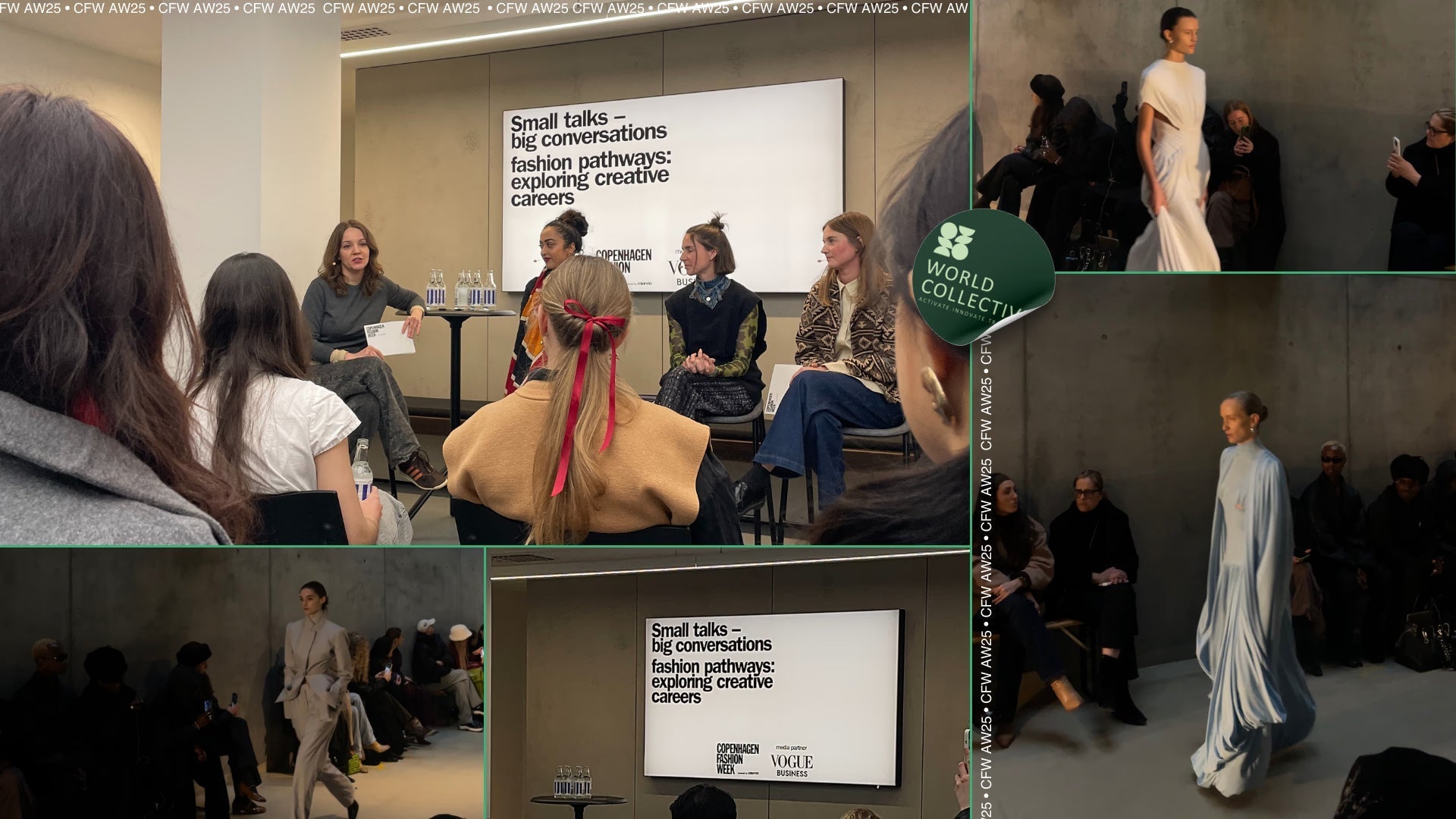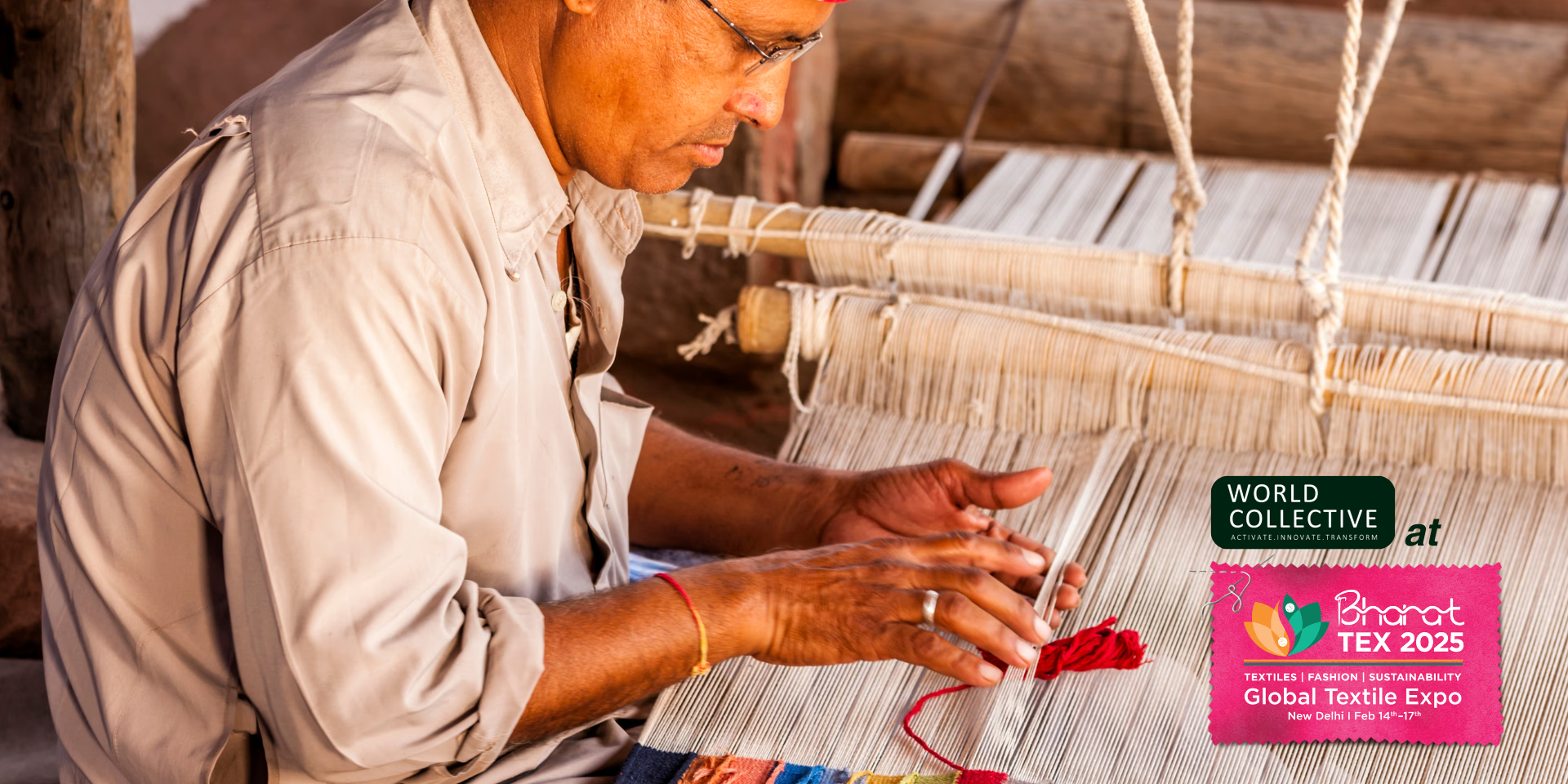Copenhagen Fashion Week (CPHFW) has established itself as the industry’s most forward-thinking fashion week, demonstrating that innovation, responsibility, and commercial success can go hand in hand.
With strict sustainability requirements, cutting-edge material developments, and a strong platform for emerging designers, CPHFW is no longer just a showcase—it is a driving force shaping how fashion operates.
While the runway presentations and signature Scandinavian street style were exceptional, the true highlight was connecting with SME brands, hearing their challenges, visions, and efforts firsthand.
The exchange of ideas on sourcing, scaling responsible materials, and collaborating through World Collective reinforced the urgency behind systemic change in the industry.
All in all, CPHFW AW25 left us with a sense of collective purpose, and momentum - essential elements in an industry where sustainability can sometimes feel like a burden rather than an opportunity.
Material Innovation Meets Commercial Viability
This season underscored that material innovation isn’t just about aesthetics—it’s about redefining the value of textiles and ensuring responsible production methods become commercially scalable.
FEBEN presented a collection that blended craft and contemporary relevance, working closely with artisans to integrate upcycled materials in a way that felt intentional rather than performative. Her collaboration with OnceMore reinforced how circular solutions can be effectively incorporated into high fashion without compromising creativity.
Elisabet Stamm introduced a deliberate shift away from large-scale production, refining her selection to focus on craftsmanship and financial sustainability. Her denim capsule—featuring reworked and naturally processed fabrics—merged streetwear sensibility with responsible sourcing, reinforcing the idea that fashion must slow down and become more considered. The minimalist “zen garden” presentation mirrored this ethos, emphasising refinement over excess.
Upper Hights brought Japanese denim expertise into dialogue with Nordic sensibility, unveiling a capsule collection that prioritised longevity over trend-driven production. While not fully sustainable, the brand’s emphasis on low-impact dyeing, circular design strategies, and precise craftsmanship illustrated how denim—one of fashion’s most resource-intensive materials—can be produced more responsibly.
Beyond high fashion, the conversation at CPHFW also extended to the commercial side, highlighting the role of trade shows in making these innovations accessible to a broader market.
Bridging Concept and Commerce: The Role of CIFF
The Copenhagen International Fashion Fair (CIFF) served as a crucial counterpart to CPHFW, offering a commercial platform for responsible brands to connect with buyers, retailers, and industry decision-makers. With over 1,500 exhibitors, CIFF ensured that forward-thinking runway concepts translated into retail realities.
This synergy between CPHFW’s visionary framework and CIFF’s market-driven approach signals a broader shift: responsible fashion is no longer an experimental niche—it is becoming the industry’s new standard.
Beyond the Runway: Panel Talks That Mattered
Apart from the shows, the panel talks this season were particularly sharp, providing real insight rather than surface-level discussions. One that stood out was the Vogue Business panel on careers in fashion, which highlighted that success today isn’t just about glamorous creative roles—it’s about the innovators driving real change.
-
Supply chain accountability: Greater focus on material sourcing, transparency, and ethical production.
-
Scalable business models: Moving beyond seasonal collections to long-term economic viability.
-
B2B transparency: Not just about where materials come from, but how brands operate behind the scenes—giving the innovators working in the background more visibility.
The discussion underscored that while supply chain transparency remains an urgent issue, the lack of visibility in B2B operations is equally critical. The fashion industry needs to shift the focus towards those working behind the scenes to create structural change.
The People Powering CPHFW’s Global Influence
While highlighting the brands and innovations that defined this season, it’s equally important to acknowledge the visionaries shaping CPHFW’s trajectory: CEO Cecilie Thorsmark and COO Isabella Rose Davey.
Under Thorsmark’s leadership, CPHFW has gone beyond being an event—it has become an agent of industry-wide change. Key initiatives include:
-
Strict sustainability criteria that brands must meet to participate.
-
Bans on virgin fur, exotic skins, and unsold stock destruction.
-
Collaborations with Fashion Council Germany to bring similar standards to Berlin Fashion Week.
Beyond her strong personal presence and incredible outfits at fashion week, Isabella Rose Davey has played a critical role in positioning CPHFW as a global leader in responsible fashion. As COO, she has strengthened strategic partnerships and ensured that Copenhagen Fashion Week’s influence extends far beyond Scandinavia.
This season, her efforts were felt across the industry—CPHFW had more momentum than ever, securing its place as a key player in global fashion discourse.
Final Thoughts
More than ever, Copenhagen Fashion Week is leading, not following. Its ability to balance creativity, commercial viability, and responsibility has made it the blueprint for how fashion weeks should operate.
Collaboration remains its biggest strength. Initiatives like the CPHFW NEWTALENT scheme, the Zalando Visionary Awards, and GANNI’s ongoing support for emerging designers reinforce that responsible fashion requires ecosystem-wide participation.
CPHFW demonstrated that structured frameworks can be both ambitious and actionable. With trade fairs like CIFF, major brands backing emerging talent, and industry leaders advocating for greater transparency, CPHFW isn’t just keeping up with industry shifts, it feels like it is setting the pace.
For us at World Collective, this season was an invaluable opportunity to connect with industry leaders, material innovators, and emerging brands. Understanding their challenges and exploring how we can help make responsible sourcing more accessible reaffirmed that collaboration is essential in making lasting industry change.
CPHFW AW25 proved that real change in fashion comes from collective action. And this season, Copenhagen played a key role in driving the conversation forward.


